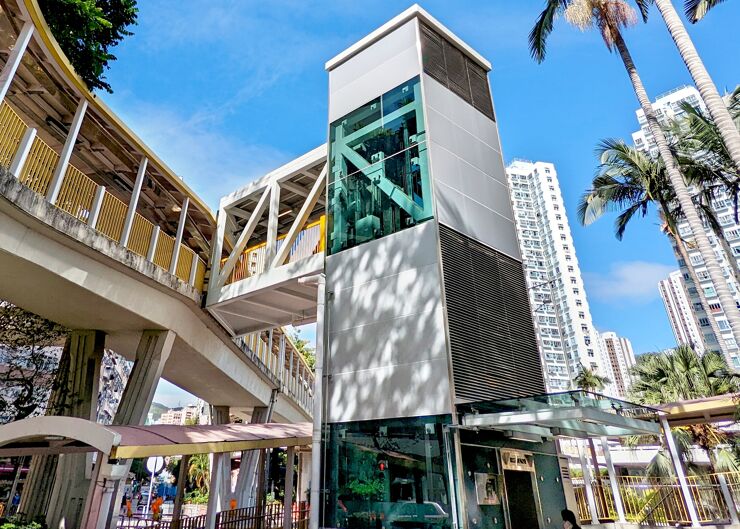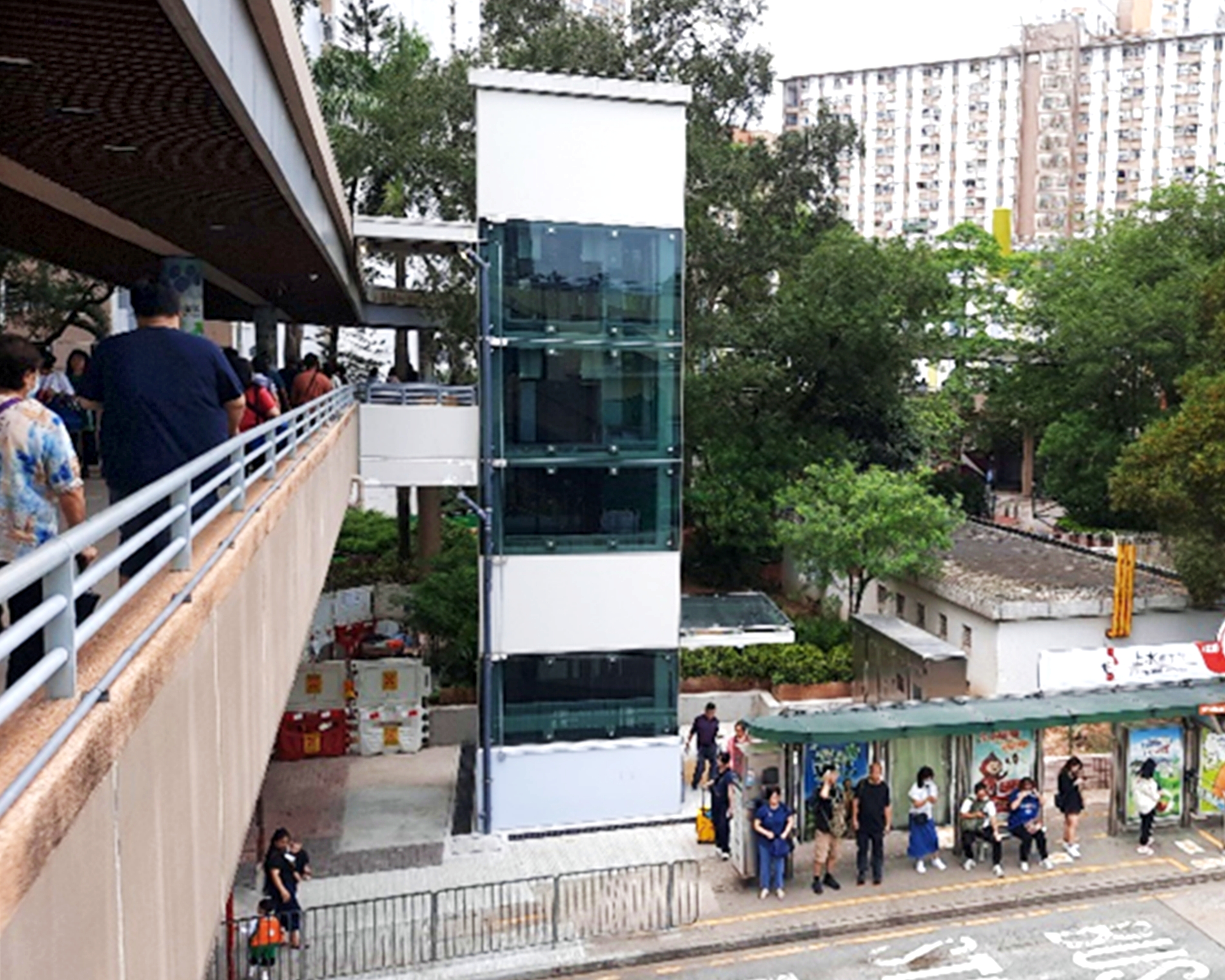
A programme of NEC contracts is being used to retrofit barrier-free access facilities to existing footbridges in Hong Kong to improve walkability in the city. The contracts have been let by the Highways Department (HyD) of the Government of the Hong Kong Special Administrative Region of China as part its Universal Accessibility programme, which it launched in 2012.
The aim of the programme is to retrofit step-free-access in the form of lifts and ramps to nearly 400 existing public footbridges, elevated walkways and subways. One of the earlier contracts, a HK$202 million (£21 million) NEC3 Engineering and Construction Contract (ECC) Option B (priced contract will bill of quantities), featured in an NEC case study in 2021.
This case study is about nine of the following contracts, all of which involve Mannings (Asia) Consultants Limited. Worth a total of HK$3,413 million (£347 million), they involve retrofitting 250 barrier-free access facilities to 149 existing walkways. The programme of works started in August 2019 and – thanks to extensive sharing of knowledge and lessons learned between the various project teams – one of the latest ones is due for completion on time and budget in July 2026.
NEC Users’ Group silver member HyD has adopted four NEC3 ECC Option A (priced contract with activity schedule), one NEC3 ECC Option B, two NEC4 ECC Option A and two NEC4 ECC Option C (target contract with activity schedule) to deliver the programme. Contract values range from HK$134 million for six footbridges with 11 lifts, to HK$941 million for 31 footbridges with 47 lifts.
The contractors are Kuly Construction and Engineering, Dixie Engineering, China Geo-Engineering, Tail Lee Engineering, WYC Joint Venture, China National Chemical Engineering, Dix Construction and Transportation, and Build King–Richwell Engineering Joint Venture (two contracts).
Mannings Asia is HyD’s NEC project manager delegate and NEC supervisor on seven of the contracts. On the two NEC4 ECC Option C contracts won by Build King–Richwell Engineering Joint Venture, Mannings Asia is working as the contractor’s designer.
This project was highly commended for the 2024 NEC Martin Barnes Award for Recognising Project Excellence and Innovation.
Collaborative approach
Mannings director Simon Ng says the key challenge on all contracts was to complete construction efficiently in limited spaces close to existing structures. ‘Complicated interfacing issues arose on every project and there was always a high chance of conflict with underground obstructions and uncharted utilities. Fortunately all the project teams embraced the NEC “spirit of mutual trust and co-operation” to achieve a high level of collaboration across the programme to overcome these challenges.’
To facilitate the process he says HyD and Mannings Asia set up a chief resident engineer’s office to formalise, standardise and exchange design and contractual information, sharing experience gained from each contract and project. ‘For instance, when one project team received certain enhanced maintenance requirements from the maintenance agent of the completed lifts, these requirements were instantly shared and discussed amongst other teams for a co-ordinated approach to comply with these requirements more effectively.’
Also, by analysing and sharing historic project data, performance metrics and external factors, Ng says the chief resident engineer’s office used the NEC early warning system as a predictive analysis tool to identify patterns, trends and potential risks. ‘This proactive approach enabled us to identify and resolve risks before they come into existence. For example, when one of the contracts received comments from the Mass Transit Railway Corporation Limited on a works proposal within a railway protection zone, such comments were immediately shared with other contracts for incorporation into their similar submissions.’
He says through the continuous evaluation and sharing amongst project teams on ideas which had brought benefits to the programme of certain projects, such as constructing precast units for certain concrete elements, the project teams are setting targets to advance completion for all projects. ‘For example, in one of our recent achievements, a section of the works was completed 11 months ahead of the first programme, which is a 37% improvement.’
Maximising value
Ng says with limited lift and steelwork subcontractors in the market, the chief resident engineer’s office also developed a resource allocation system through regular meetings with the project teams, the subcontractors and HyD’s project officers as necessary to forecast the resource peaks and make appropriate arrangements to even them out. ‘This helped to reduce peak labour demand by up to 30%’.
 He says to further boost productivity on two contracts, HyD piloted modular integrated construction (MiC) for lift construction. ‘On these contracts HyD also adopted NEC Option X22 on Early Contractor Involvement to harvest the contractors’ expertise in implementing MiC in the most cost-effective way.’
He says to further boost productivity on two contracts, HyD piloted modular integrated construction (MiC) for lift construction. ‘On these contracts HyD also adopted NEC Option X22 on Early Contractor Involvement to harvest the contractors’ expertise in implementing MiC in the most cost-effective way.’
Ng says stage one of the two contracts required the contractor to complete site investigation and utilities diversion works and then design the lifts ensure constructability. ‘The aim was to minimise the risk of delays due to subsequent design changes caused by uncharted utilities. With the adoption of Option X22, the contractor could revise the completion date before starting stage two, such that HyD benefitted from the time saving. This collaborative use of Option X22 meant all parties made an effective contribution to achieving the common goal of successful and speedy completion of the projects.’
He says MiC also shortened the overall construction period, enhanced the working environment and improved safety performance. ‘It involved the off-site assembly of lift shaft superstructures with lift equipment in a factory setting in parallel with on-site foundation works, so that the completed modules could be installed on site as soon as foundation works had been completed. With most of the components pre-installed, the method shortened the time required for on-site commissioning by up to 6 months.’
Ng adds that to achieve the goal of greenhouse gas emissions neutrality, energy-efficient designs have been developed on the more recent projects to minimise electricity consumption in the operation phase. ‘These include light-emitting-diode lighting, mechanical ventilation in place of air-conditioning and efficient lift motor systems with an energy-saving standby mode. These energy-efficient designs have reduced the carbon dioxide emissions of the newer lifts by around 60%, and are being shared across the programme.’
Project highlight video
Benefits of using NEC
- NEC requirement to act in a spirit of ‘mutual trust and co-operation’ has led to collaboration between the project teams across nine contracts and nearly 150 projects.
- NEC-inspired collaboration has ensured that limited resources have been efficiently shared across the projects, together with early warnings and risk mitigation measures.
- Buildability benefits of using NEC Option X22 on Early Contractor Involvement and modular integrated construction have been also shared across projects, along with suggestions for continuing design and buildability improvements




